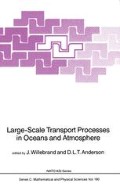Abstract
A coupled ocean-atmosphere model of El Nino and the Southern Oscillation is discussed. The model ocean is a reduced-gravity system that also includes an equation for the temperature of the layer, T. The model atmosphere is a linear, single-baroclinic mode system driven by convection, Q. The wind stress used to drive the model ocean is proportional to the wind velocity produced by the model atmosphere, while Q over the ocean is a function only of T. Some of the solutions also involve land as well as ocean; in that case, Q over land is either a fixed forcing function or it is set to zero.
For a broad range of model parameters, solutions oscillate at the long time scales associated with El Nino and the Southern Oscillation (ENSO). In all cases, the basic process causing the oscillation is the growth of unstable disturbances to finite amplitude and their subsequent slow eastward propagation. The dynamics of the instability are nicely illustrated in the simpler analyses of Lau (1981), Philander et al. (1984) and others.
Solutions compare favorably with observations of ENSO in several respects. For example, for a basin geometry that most resembles the Indian and Pacific Oceans, strong permanent convection exists in the eastern Indian Ocean, and there is a oscillation in the Pacific Ocean with a period of about five years. Associated with this oscillation is a patch of convection that develops in the central and western ocean and propagates into the eastern ocean before dissipating. Solutions do not compare favorably in other ways. A major limitation is that they do not simulate the rapid onset or intermittancy of ENSO.
Access this chapter
Tax calculation will be finalised at checkout
Purchases are for personal use only
Preview
Unable to display preview. Download preview PDF.
References
Anderson, D.L.T., 1984: An advective mixed layer model with applications to the diurnal cycle of the low-level East African Jet. Tellus, 36A 278–291.
Anderson, D.L.T. and J.P. McCreary, 1985a: Slowly propagating disturbances in a coupled ocean-atmosphere model, J. Atmos. Sea. (To appear.)
Anderson, D.L.T. and J.P. McCreary, 1985b: A note on the role of the Indian Ocean in a coupled ocean-atmosphere model of El Nino and the Southern Oscillation, J. Atmos. Sci. (Submitted.)
Cane, M.A. and S. Zebiak, 1985: A theory for El Nino and the Southern Oscillation. (To be submitted.)
Egger, J., 1977: On the linear theory of the atmospheric response to sea surface temperature anomalies. J. Atmos. Sci., 34, 603–614.
Gill, A.E., 1980: Some simple solutions for heat-induced tropical circulation. Q.J. Roy. Met. Soc., 106, 447–462.
Gill, A.E., 1985: Elements of coupled ocean-atmosphere models for the tropics. In Coupled Ocean-Atmosphere Models, Amsterdam: Elsevier. J.C.J. Nihoul Ed., p. 303–328.
Gill, A.E. and E.M. Rasmusson, 1984: The 1982/83 climate anomaly in the equatorial Pacific. Nature, 306, 229–232.
Haney, R.L., 1971: Surface thermal boundary conditions for ocean circulation models. J. Phys. Oceanogr., 1, 241–248.
Hirst, A.C., 1985: Free equatorial instabilities in simple coupled atmosphere-ocean models. In Coupled atmosphere-ocean models, Amsterdam: Elsevier. J.C.J. Nihoul Ed., p. 153–166
Hughes, R.L., 1979: A highly simplified El Nino model. Ocean Modelling, No. 22
Hughes, R.L., 1980: On the equatorial mixed layer. Deep Sea Res., 27A, 1067–1078.
Hughes, R.L., 1984: Developments on a highly simplified El Nino Model. Ocean Modeling, No. 54 (unpublished manuscript).
Lau, K.M., 1981: Oscillations in a simple equatorial climate system. J. Atmos. Sci, 38, 248–261.
Lau, K.-M, 1984: Subseasonal scale oscillation, biomodal climatic state and the El Nino/Southern Oscillation. In Coupled atmosphere-ocean models, Amsterdam: Elsevier. J.C.J. Nihoul Ed., p. 29–40.
Lau, N.-C, 1981: A diagnostic study of recurrent meteorological anomalies appearing in a 15-year simulation with a GFDL general circulation model. Mon. Wea. Rev., 109, 2287–2311.
Lau, N.-C, and A.H. Oort, 1985: Response of a GFDL General circulation model to SST Fluctuations observed in the tropical Pacific Ocean during the period 1962–1976. In: Coupled Ocean-Atmosphere Models, Amsterdam: Elsevier. J.C.J. Nihoul Ed., p. 289–302.
Manabe, S., and D.G. Hahn, 1981: Simulation of atmospheric variability. Mon. Wea. Rev., 109, 2260–2286.
McCreary, J.P., 1983: A model of tropical ocean-atmosphere interaction, Mon. Wea. Rev., 111. (2), 370–389.
McCreary, J.P. and D.L.T. Anderson, 1984: A simple model of El Nino and the Southern Oscillation. Mon. Wea. Rev., 112, 934–946.
Nobre, C.A., 1983: Tropical heat sources and their associated large-scale atmospheric circulation. Ph.D.thesis, M.I.T., Cambridge, Mass.
Philander, S.G.H., T. Yamagata and R.C. Pacanowski, 1984: Unstable air-sea interactions in the tropics. J. Atmos. Sci. (In press.)
Webster, P.J., 1972: Response of the tropical atmosphere to local steady forcing. Mon. Wea. Rev., 100, 518–541.
Welander, P. and B. Long, 1985: The overall mechanism of the El Nino phenomenon. (Submitted to Science.)
Yamagata, T., 1985: Stability of a simple air-sea coulped model in the tropics. In: Coupled atmosphere-ocean models, Amsterdam: Elsevier. J.C.J. Nihoul Ed., p. 637–658.
Zebiak, S.E., 1982: A simple atmospheric model of relevance to El Nino. J. Atmos. Sci., 39, 3017–2027.
Zebiak, S.E., 1984: Tropical atmosphere-ocean interaction and the El Nino/Southern Oscillation phenomenon. Ph.D. thesis. M.I.T., Cambridge, Mass.
Author information
Authors and Affiliations
Editor information
Editors and Affiliations
Rights and permissions
Copyright information
© 1986 D. Reidel Publishing Company, Dordrecht, Holland
About this chapter
Cite this chapter
McCreary, J.P. (1986). Coupled Ocean-Atmosphere Models of El Nino and the Southern Oscillation. In: Willebrand, J., Anderson, D.L.T. (eds) Large-Scale Transport Processes in Oceans and Atmosphere. NATO ASI Series, vol 190. Springer, Dordrecht. https://doi.org/10.1007/978-94-009-4768-9_7
Download citation
DOI: https://doi.org/10.1007/978-94-009-4768-9_7
Publisher Name: Springer, Dordrecht
Print ISBN: 978-94-010-8617-2
Online ISBN: 978-94-009-4768-9
eBook Packages: Springer Book Archive

